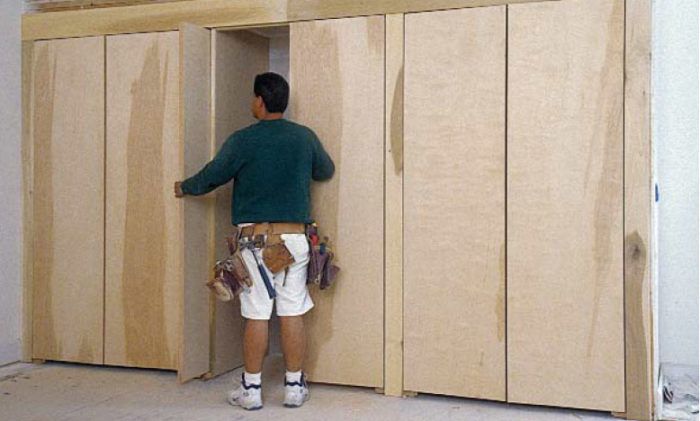Disappearing Doors
Pivoting foldaway doors are a good option for a closet or home office.

Synopsis: Pivoting pocket doors can be the perfect solution for a home office. Specialized hardware allows potentially obtrusive doors to swing open and slide into pockets, getting the doors out of the way. This article walks you through what can be a tricky installation.
I got a call to install three pairs of foldaway doors for a home office. When I went to measure the job for materials, I was surprised to see a 12-ft. wide by 7-ft. tall closet opening in a guest bedroom. The homeowner wanted me to install full-size doors that hinge open, then slide back into pockets in the sidewalls, like the doors on an entertainment center.
The homeowner wanted to use the opening as a convertible office, but he didn’t want his desk and files visible when he had guests. He also needed the doors to open out of the way so that he wouldn’t feel as if he were working in a closet, and he had just the hardware for the job.
I had to familiarize myself with the Hawa-Turnaway high-precision hardware, so I opened one box. Like most carpenters, I set aside the instructions until I could understand the basic function of the hardware. After fooling with the two colossal aluminum pantographs, what I called the scissors, I began to understand the operation. The pantograph ensures that the doors glide in and out of the sidewall pocket.
But I knew I was in trouble once I opened the directions: “Warning! This product must be installed to exact dimensions in a precision built cabinet. Do not attempt to install this product in a rough opening on a job site.” I showed this warning to the general contractor and the homeowner, and they asked me to take the job and to do my best.
The key to installing the system properly is getting the top and bottom tracks level, plumb and perfectly parallel; otherwise, the doors bind in the track and do not open or close properly. I installed the upper and lower plastic U-shaped tracks in wood blocks because the doors needed to clear a carpeted floor and a head jamb. Creating a perfectly level plane was a prerequisite for this job. The floor was miserably out of level, but I could shim the blocks pretty easily. In addition, the blocks acted as backing cleats for the plywood panels needed to create the pocket walls. I used a plunge router to cut the dadoes in the blocks for the tracks, then installed and shimmed them level. Installing the top blocks was much easier.
The back of the large pantograph was mounted to the sidewall in two locations: I bolted the top to the wall, but the bottom had to be mounted in a vertical track secured with Allen-screw pins so that the pantograph could be adjusted. I fastened the doors to leaf hinges that mounted in a track on the front of the pantograph. By sliding the hinges in the track, I could raise and lower each door, so aligning the tops of all the doors was a snap. Adjustable steel guides keep the hardware on track.
I wouldn’t recommend that just anyone take on a pair of full-sized foldaway doors – not to mention three of them. But with some careful planning and patience, installing this precision hardware can result in a smoothly operating, slick pair of hidden doors.
If The Frame Isn’t Perfect, The Doors Won’t Work
To see step by step photos of the installation of pivoting pocket doors, click the View PDF button below.






